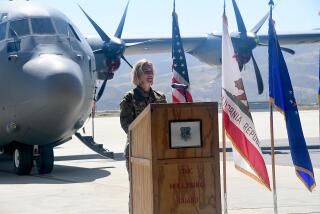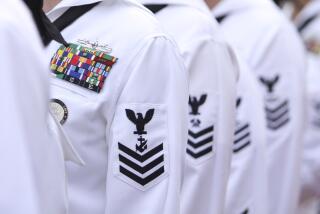GSA Rejects $79 Vacuum Cleaner, Opts for $348 Model : Navy Man Fired in Ashtray Probe Had Sought Less Expensive Unit but Was Overruled
- Share via
SAN DIEGO — The General Services Administration refused to allow a Navy commander at Miramar Naval Air Station to purchase a $79 vacuum cleaner last year, and instead instructed him to order a $348 model from a government supply catalogue, according to internal memos provided to The Times.
Cmdr. Jerry L. Fronabarger, one of two officers dismissed from Miramar earlier this month in connection with the purchase of two aircraft ashtrays for $659 each, requested a GSA waiver in May, 1984, to buy an industrial vacuum cleaner manufactured by Johnstone Supply of San Diego.
But R. H. Ross, chief of the GSA’s supply determination branch, told Fronabarger in a June 14, 1984, memo: “Federal property management regulations . . . specifically prohibit the GSA from granting waivers based on cost considerations alone. Since there appears to be no appreciable difference between the GSA item and the one you desire . . . your request cannot be granted.”
Letter to Weinberger
The vacuum cleaner case was cited by Rep. Bill Lowery (R-San Diego) in a July 18 letter telling Defense Secretary Caspar W. Weinberger that supply abuses are spread throughout the government and not limited to Miramar. In the letter he asked for an explanation for the dismissals of Fronabarger and Capt. Gary E. Hakanson.
“If the Navy supply system and the GSA require Navy professionals to buy overpriced parts and equipment, how can those same professionals be blamed for improper procurement practices?” Lowery asked.
Fronabarger, who is moving to Philadelphia, was reached in Texas. He said in a telephone interview from there that he was never given a “practical” reason for being told to purchase the more expensive vacuum cleaner.
“It didn’t make any sense then and it doesn’t make any sense now,” Fronabarger said.
Blame Placed
Vince Burns, deputy director of procurement for the GSA’s Federal Supply Service in Washington, blamed Ross for failing to properly investigate the difference between the two vacuum cleaner models. Burns said the more expensive Bissell Inc. vacuum cleaner has a 1.7-horsepower motor and 10-gallon storage tank compared to a 1.3-horsepower motor and six-gallon capacity in the Johnstone brand.
“It was a mistake on our part,” Burns said. “If Miramar determined that the light-duty industrial-type vacuum was sufficient for their needs, they should have been able to go out and buy it.”
But Burns confirmed that purchasing policies do not permit federal agencies to buy less expensive items outside the GSA supply catalogue when the models are the same as those listed in the government manual. Burns said that this policy protects contractors who submitted the lowest bids to provide government supplies.
Fronabarger said that a wet/dry vacuum cleaner was needed to clean up plumbing spills in Miramar’s public works division. Because of GSA’s action, no vacuum was purchased. Instead, maintenance personnel did the cleanup by hand.
Revised Catalogue
Since March, the GSA has added lower-priced industrial vacuum cleaners to its catalogue listing, Burns said. Federal agencies can now buy a vacuum cleaner manufactured by Shop-Vac Corp. in Williamsport, Pa., for $73.47.
Providing further documentation of widespread supply abuses, Lowery’s July 18 letter to Weinberger listed six additional purchases of high-priced aircraft ashtrays. These included one ashtray purchased by Norfolk Naval Air Station in July, 1980, for $519.92 and another for $637.79 in February, 1982, by the aircraft carrier Kitty Hawk.
Three other ashtray purchases were made at Miramar--three in August, 1978, at $394 apiece, two in November, 1981, at $569 apiece and two in May, 1982, at $616 apiece.
A spokesman for Grumman Corp., supplier of the ashtrays, said the price differences were due to inflation and the quantities ordered.
Mike Drake, a Grumman spokesman in Bethpage, N.Y., said that if the company is able to verify the purchase of the six additional ashtrays listed in Lowery’s letter, it will offer a credit to the Navy.
Grumman recently repaid the Navy $100,000 for purchases including seven ashtrays, two wrench sockets for $800 and an elevator ground lock for F-14 Tomcat fighter planes for $2,410.
Publicized reports of the Miramar ashtray purchases in May led to the firings of Fronabarger as supply officer, Hakanson as commanding officer and Rear Adm. Thomas J. Cassidy Jr. as commander of Miramar’s fighter air early warning wing.
But when it was learned that Fronabarger and Hakanson did not begin working at Miramar’s supply division until mid-1982, the Navy launched an investigation to determine who was responsible for the purchases.
Superb Performances
According to excerpts of the 16-inch thick investigation report provided by Lowery, the Navy probe found that all three had performed “superbly” and recommended that they be exonerated.
Three weeks after the report was finished, Navy Secretary John Lehman reinstated Cassidy and upheld Weinberger’s dismissal of Fronabarger and Hakanson.
More to Read
Inside the business of entertainment
The Wide Shot brings you news, analysis and insights on everything from streaming wars to production — and what it all means for the future.
You may occasionally receive promotional content from the Los Angeles Times.










